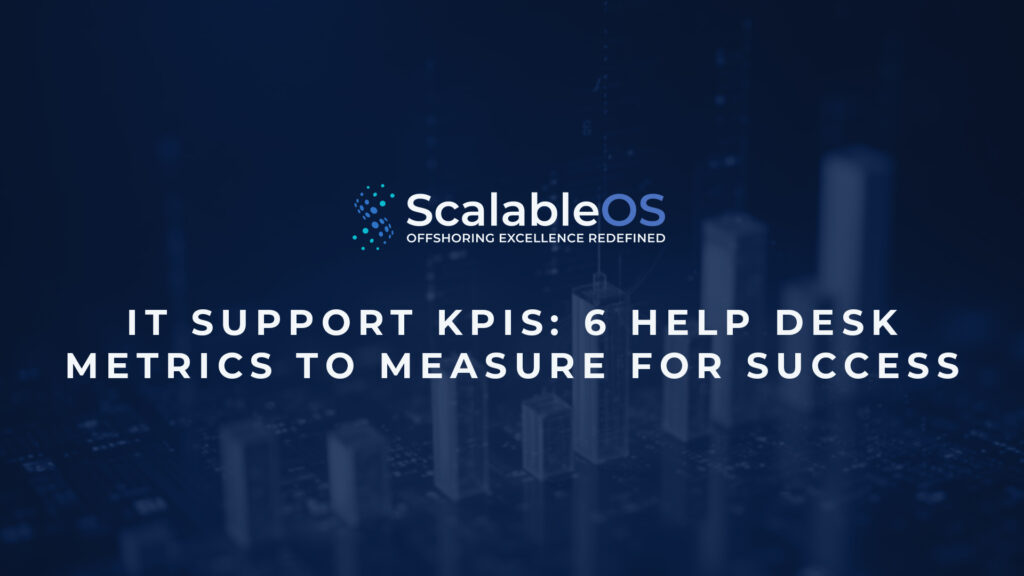In managed and outsourced IT services, you’re only as good as your metrics. Key performance indicators (KPIs) reveal the true story behind your team’s speed, quality, and ability to support increasing demands.
As IT environments grow more complex, clear and actionable KPIs are critical to keeping your help desk operations on track. Otherwise, you risk high costs, unresolved tickets, team burnout, and service level agreement (SLA) violations. Worse, your clients may start questioning the value you deliver.
This article walks you through the most essential IT service desk metrics to track—and how you can turn them into levers for smarter staffing, better service, and scalable growth.
What Are IT Support KPIs and Why Do They Matter?
IT support KPIs are measurable values that track the performance of your help desk. They provide a clear picture of what’s working, what’s lagging, and where to make improvements. These metrics also help standardize reporting across your service desk, making performance reviews more objective and less subjective.
For managed service providers (MSPs), KPIs also carry weight in contract renewals and SLA compliance. Clients want proof that you’re delivering value, and KPIs offer the data to back it up.
What are the Key Help Desk Metrics to Track in 2025?
Don’t wait for tickets to pile up, SLAs to get tighter, or client expectations to rise. These six service desk KPIs help you stay ahead of the chaos and deliver IT support that actually works.
1. First contact resolution (FCR)
FCR measures the percentage of support tickets your IT team resolves during the first interaction. It’s a strong indicator of how effective your agents are at solving issues promptly—crucial for boosting client satisfaction, maintaining SLAs, and preventing ticket backlogs.
Several factors influence FCR, including ticket complexity, agent experience, access to tools such as knowledge bases or remote-control platforms, and the quality of agent training. Hence, FCR is typically measured monthly for accuracy, but you can track it at any interval depending on your operational goals.
2. Mean time to resolution (MTTR)
This service desk metric tracks the average time it takes to resolve a support ticket fully, from initial report to final closure. While FCR focuses on quick wins at first contact, MTTR reveals how efficiently your team handles the entire resolution process.
A high MTTR often signals deeper issues, such as:
- Slow problem detection (high MTTD)
- Persistent, unresolved problems
- Inability to act quickly
- Lack of observability or actionable insights
- Ineffective alerting systems
- Communication breakdowns
- Insufficient customer-facing documentation
Setting realistic MTTR goals is key. Take this help desk KPI example: if you’re supporting a SaaS product with moderate complexity, you can aim to resolve standard issues within eight hours and escalated issues within 24 hours. That gives agents enough time to troubleshoot properly without leaving users waiting too long.
3. Average response time
ART tracks how quickly your help desk responds to a ticket. While resolution may take longer, that first reply sets the tone. In fact, 90% of customers consider an “immediate” reply important, and 60% define “immediate” as under 10 minutes.
Delayed responses create more work. When customers don’t hear back promptly, they may reach out again through other channels, resulting in duplicate tickets and unnecessary pressure on your team. Over time, slow ART can damage your brand’s image, reduce customer loyalty, and even affect revenue.
4. Ticket volume trends
Ticket volume measures the number of support requests received over a given period. It helps you spot patterns, plan capacity, and improve service delivery.
If you receive too many tickets, it may be because of buggy systems, poor UX, or poorly communicated product changes. On the flip side, a dip in ticket volume might indicate disengaged users or broken ticket flows. Tracking trends can prepare you for seasonal surges, prevent backlogs, and fine-tune staffing.
This metric also supports better SLA management. When you understand your team’s handling capacity, you can forecast demand more accurately and avoid overloading agents.
5. Customer satisfaction score (CSAT)
This help desk KPI measures the level of satisfaction users have with the support they receive. Unlike time-based metrics, CSAT captures the quality of the experience from the end-user’s perspective, not just how quickly a ticket was closed.
After resolving a ticket, you can send a simple survey asking users to rate their satisfaction on a scale (usually 1 to 5 or 1 to 10). Then calculate your CSAT by dividing the number of satisfied responses (e.g., 4s and 5s, or 8s to 10s) by the total number of responses.
A fast resolution doesn’t mean much if the customer walks away frustrated. If your CSAT score is low, that’s your cue to investigate ticket trends, tone of communication, and quality of support. Some ways you can improve your CSAT are:
- Keeping surveys short, timely, and easy to complete
- Training agents on empathy and communication, not just technical fixes
- Personalizing support interactions to avoid robotic replies
- Using low-rated tickets as coaching opportunities
6. Technician utilization rate
This metric tracks how much of a technician’s time is spent on productive, ticket-related work—responding to users, resolving issues, and handling support tasks. In short, this metric helps you balance workloads. A low rate may indicate that you’re overstaffed or assigning tasks inefficiently, while a high rate may suggest overwork and an increased risk of burnout.
Use this KPI to adjust staffing, rebalance assignments, or automate repetitive work. When your team operates at a sustainable pace, you protect both service quality and employee well-being.
How to Use KPIs to Improve Service Desk Performance?
Tracking KPIs isn’t enough—you need to act on them. Below are some help desk metrics best practices that lead to real operational improvements.
-
Set realistic KPI targets with benchmarks
Don’t chase industry gold standards mindlessly. For example, if most of your tickets are complex B2B issues, aiming for a 90% FCR might backfire. Instead, aim for a more achievable 65%–75% FCR, based on your historical performance and ticket mix. Benchmark against similarly sized teams and adjust quarterly based on trends.
-
Automate reports via service desk tools
Use service desk platforms to schedule and generate regular reports. Weekly dashboards can be used to track FCR, MTTR, CSAT, and volume trends in real time—giving you a live pulse on performance.
-
Train staff using KPI feedback
Use performance data to guide coaching. If an agent’s FCR dropped by 10% over two weeks, review their recent tickets to identify common blockers. Then, develop a quick workshop or coaching session to address those gaps. Monthly one-on-ones are also great opportunities to review individual KPIs and identify specific skills to improve.
-
Align with client SLAs and business outcomes
Your KPIs should reflect the commitments made in your contracts. For example, if your SLA commits to a 2-hour response time and your average response time hits 3 hours, that’s a clear signal to take action. Use the data to adjust team priorities, make staffing changes, or realign expectations during quarterly business reviews.
Don’t Just Track—Transform Your IT Support
KPIs give you direction, and it’s how you use them that drives real improvement. When you track the right help desk metrics and act on them, you create a more agile, efficient, and client-focused support.
Start with the core IT service desk KPIs to gauge your team’s efficiency, elevate user satisfaction, and scale without breaking SLA commitments.
At ScalableOS, an outsourcing company in the Philippines, we help IT teams like yours go beyond ticket resolution. Our managed offshore support teams are built to hit your performance goals—backed by transparent reporting, 24/7 coverage, and real-time alignment with your internal standards.
Explore our IT support services to see how we can help your business scale with confidence. Take a look at our pricing.

Chris Van Vladricken
Chris is the CEO and Co-Founder of ScalableOS, with over 18 years of experience in both Philippines offshoring and Information Technology. A longtime member of EO Seattle, he’s passionate about building high-impact teams that help businesses grow while creating meaningful opportunities in the Philippines. His people-first approach drives the company’s mission to deliver tailored, strategic offshoring solutions that help businesses scale smarter.


